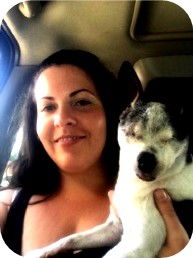Fear Free Procedures and Handling
by Bryana Walters
We are on our second Final Refuge foster dog, Rowdy. He’s a cute tiny chihuahua who came to us with no teeth and one eye. During our first month with him, it became clear that his other eye was bothering him too. So we brought him to the vet and found out that he needed not one but two different eye drops. During his exam he also was in a full-on panic and trying to bite with his no-teeth. I thought how fun it was going to be to try and get eye drops into this little guy. Not!
He lovingly earned his nickname of “Baby Shark” if you try and “do things” to him. He’s fine with you touching him, but the second he believes the touch could be related to you checking something or looking at something, the shark comes out. As a professional dog trainer, I recently became certified as a Fear Free Trainer, so I learned more about helping animals feel better about medical procedures and handling. I thought about how my experience must not be unique. Many of my fellow fosters and other dog owners probably also need to do things that their dogs may not love. Not all dogs turn into baby sharks; my first Final Refuge foster dog, Gramma Rose, also needed two different eye drops. She didn’t become aggressive about it, but she went all the way to the other side of the room and hid in the corner when I tried to give the eye drop; it was like she had the Jaws of Life closing down on her eyelid. A very clear signal that she was not enjoying the experience.
Dogs can have different responses to medical procedures and handling, but it seems in my experience, it’s not necessarily something that dogs enjoy. But we can change that! Gramma Rose was extremely food motivated, so over time, she eagerly offered her eye at my cue of, “Time for eye drops!” in order to get her treats. My new little guy was not a happy camper about the eye drops, so we found that pairing the eye drops with lunch meat (so this was a two-person event) was the trick. However, with one person, you couldn’t get the meat in his mouth, open his eye and put the drops in at the same time without some sharkiness. So I began muzzle training which will be great for taking him to the vet also.
Muzzles are wonderfully helpful tools and can be worn by the dog happily. Think of a muzzle like a seat belt that can be worn just in case an accident happens. When dogs are in pain or scared, they can act differently than your normal sweet dog and muzzles can prevent bites. Muzzle training is actually pretty easy, by pairing delicious food and the muzzle. There are great resources available at MuzzleUpProject.com.
In Rowdy’s case, his eye became worse and needed to be removed so muzzle training has taken a break while he heals. He was restless and extremely aggressive with his eye drops one day and we could tell something was wrong. Listen to your instincts and your dog! When you are working with your dog and something suddenly seems worse or different after you have been making progress, it may be time for a vet appointment.
Giving eye drops, pills, injections, or other treatments don’t have to be terrible and scary. If you can find something your dog really enjoys (some favorites of dogs are liverwurst, spray cheese, peanut butter, cream cheese, etc.) and pair that with the procedure or handling, you can teach your dog to associate the two things. Then you have a pet who can enjoy, or at least not hate, what you are doing to them. If you can do this right away when you are given the “homework” of giving eyedrops or other treatments, you can build a positive association immediately. If your dog already hates whatever treatment you are doing, you can still overcome this but will likely have to do some desensitization and counterconditioning with your dog so they can replace their previous bad association with a new good one. You may need a qualified and certified dog trainer to help you.
There’s no reason that giving eye drops or other treatments has to be a miserable experience for the pet (and many times, in turn, the human). Please do your dog and yourself a favor and make these procedures and handling fear free experiences for them so they actually enjoy participating in the treatment.


